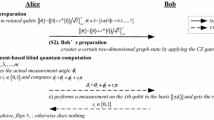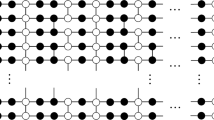Abstract
The universal blind quantum computation with weak coherent pulses protocol is a practical scheme to allow a client to delegate a computation to a remote server while the computation hidden. However, in the practical protocol, a finite data size will influence the preparation efficiency in the remote blind qubit state preparation (RBSP). In this paper, a modified RBSP protocol with two decoy states is studied in the finite data size. The issue of its statistical fluctuations is analyzed thoroughly. The theoretical analysis and simulation results show that two-decoy-state case with statistical fluctuation is closer to the asymptotic case than the one-decoy-state case with statistical fluctuation. Particularly, the two-decoy-state protocol can achieve a longer communication distance than the one-decoy-state case in this statistical fluctuation situation.




Similar content being viewed by others
Explore related subjects
Discover the latest articles, news and stories from top researchers in related subjects.References
Feynman, R.P.: Simulating physics with computers. Int. J. Theor. Phys. 21(6), 467–488 (1982)
Deutsch, D., Jozsa, R.: Rapid solution of problems by quantum computation. Proc. R. Lond. Ser. A Math. Phys. Sci. 439(1907), 553–558 (1992)
Grover, L. K.: A fast quantum mechanical algorithm for database search. In: Proceedings of the Twenty-Eighth Annual ACM Symposium on Theory of Computing, pp. 212–219. ACM (1996)
Shor, P. W.: Fault-tolerant quantum computation. In: Foundations of Computer Science, Proceedings., 37th Annual Symposium on. IEEE, Conference Proceedings, pp. 56–65 (1996)
Shor, P.W.: Polynomial-time algorithms for prime factorization and discrete logarithms on a quantum computer. SIAM Rev. 41(2), 303–332 (1999). https://doi.org/10.1137/S0036144598347011
Childs, A.M.: Secure assisted quantum computation. Quantum Inf. Comput. 5(6), 456–466 (2005)
Arrighi, P., Salvail, L.: Blind quantum computation. Int. J. Quantum Inf. 4(05), 883–898 (2006)
Broadbent, A., Fitzsimons, J., Kashefi, E.: Universal blind quantum computation. In: Foundations of Computer Science. FOCS’09. 50th Annual IEEE Symposium on. IEEE, Conference Proceedings, pp. 517–526 (2009)
Reichardt, B.W., Unger, F., Vazirani, U.: Classical command of quantum systems. Nature 496(7446), 456–460 (2013)
Broadbent, A., Gutoski, G., Stebila, D.: Quantum one-time programs. In: Advances in Cryptology-CRYPTO 2013: 33rd Annual Cryptology Conference, Santa Barbara, CA, USA, August 18–22, Proceedings, Part II, pp. 344–360. Springer (2013)
Morimae, T.: Continuous-variable blind quantum computation. Phys. Rev. Lett. 109(23), 230502 (2012)
Sueki, T., Koshiba, T., Morimae, T.: Ancilla-driven universal blind quantum computation. Phys. Rev. A 87(6), 060301 (2013)
Morimae, T., Fujii, K.: Blind quantum computation protocol in which alice only makes measurements. Phys. Rev. A 87(5), 050301 (2013)
Li, Q., Chan, W.H., Wu, C., Wen, Z.: Triple-server blind quantum computation using entanglement swapping. Phys. Rev. A 89(4), 040302 (2014)
Morimae, T., Dunjko, V., Kashefi, E.: Ground state blind quantum computation on AKLT state. Quantum Inf. Comput. 15, 200–234 (2015)
Morimae, T., Fujii, K.: Blind topological measurement-based quantum computation. Nat. Commun. 3, 1036 (2012)
Chien, C.-H., Van Meter, R., Kuo, S.-Y.: Fault-tolerant operations for universal blind quantum computation. ACM J. Emerg. Technol. Comput. Syst. 12, 9 (2015)
Takeuchi, Y., Fujii, K., Ikuta, R., Yamamoto, T., Imoto, N.: Blind quantum computation over a collective-noise channel. Phys. Rev. A 93(5), 052307 (2016). pRA. [Online]. https://link.aps.org/doi/10.1103/PhysRevA.93.052307
Sheng, Y.-B., Zhou, L.: Blind quantum computation with noise environment. arXiv preprint arXiv:1609.08902 (2016)
Giovannetti, V., Maccone, L., Morimae, T., Rudolph, T.G.: Efficient universal blind quantum computation. Phys. Rev. Lett. 111(23), 230501 (2013)
Mantri, A., Prez-Delgado, C.A., Fitzsimons, J.F.: Optimal blind quantum computation. Phys. Rev. Lett. 111(23), 230502 (2013)
Prez-Delgado, C.A., Fitzsimons, J.F.: Iterated gate teleportation and blind quantum computation. Phys. Rev. Lett. 114(22), 220502 (2015)
Dunjko, V., Kashefi, E., Leverrier, A.: Blind quantum computing with weak coherent pulses. Phys. Rev. Lett. 108(20), 200502 (2012)
Xu, K., Lo, H.-K.: Blind quantum computing with decoy states. arXiv preprint arXiv:1508.07910 (2015)
Zhao, Q., Li, Q.: Blind Quantum Computation with Two Decoy States. Springer International Publishing, Berlin (2017)
Barz, S., Kashefi, E., Broadbent, A., Fitzsimons, J.F., Zeilinger, A., Walther, P.: Demonstration of blind quantum computing. Science 335(6066), 303–308 (2012)
Barz, S., Fitzsimons, J. F., Kashefi, E., Walther, P.: Experimental verification of quantum computations. arXiv preprint arXiv:1309.0005 (2013)
Fisher, K., Broadbent, A., Shalm, L., Yan, Z., Lavoie, J., Prevedel, R., Jennewein, T., Resch, K.: Quantum computing on encrypted data. Nat. Commun. 5, 3074 (2014)
Dunjko, V., Kashefi, E.: Blind quantum computing with two almost identical states. arXiv preprint arXiv:1604.01586 (2016)
Raussendorf, R., Briegel, H.J.: A one-way quantum computer. Phys. Rev. Lett. 86(22), 5188 (2001)
Raussendorf, R., Browne, D.E., Briegel, H.J.: Measurement-based quantum computation on cluster states. Phys. Rev. A 68(2), 022312 (2003)
Jozsa, R.: ‘An introduction to measurement based quantum computation. NATO Sci. Ser. III Comput. Syst. Sci. Quantum Inf. Process. Theory Exp. 199, 137–158 (2006)
Wang, X.-B.: Beating the photon-number-splitting attack in practical quantum cryptography. Phys. Rev. Lett. 94(23), 230503 (2005)
Ma, X., Qi, B., Zhao, Y., Lo, H.-K.: Practical decoy state for quantum key distribution. Phys. Rev. A 72(1), 012326 (2005)
Feller, W.: An Introduction to Probability Theory and Its Applications: Volume I, vol. 1, 3rd edn. Wiley, New York (1973)
Dunbar, S. R.: The de moivre-laplace central limit theorem. Department of Mathematics, University of Nebraska, Lincoln/NE (2011) [Online]. https://www.math.unl.edu/~sdunbar1
Dunjko, V., Fitzsimons, J. F., Portmann, C., Renner, R.: Composable security of delegated quantum computation. In: Advances in Cryptology—ASIACRYPT 2014: 20th International Conference on the Theory and Application of Cryptology and Information Security, Kaoshiung, Taiwan, R.O.C., December 7–11, Proceedings, Part II, pp. 406–425. Springer (2014)
Maurer, U., Renner, R.: Abstract cryptography. In: The Second Symposium in Innovations in Computer Science, ICS 2011, pp. 1–21. Tsinghua University Press (2011)
Lo, H.-K., Ma, X., Chen, K.: Decoy state quantum key distribution. Phys. Rev. Lett. 94(23), 230504 (2005)
Acknowledgements
This work is supported by the National Natural Science Foundation of China (Grant Number: 61471141, 61361166006), Key Technology Program of Shenzhen, China, (Grant Number: JSGG20160427185010977) and Basic Research Project of Shenzhen, China (Grant Number: JCYJ20150513151706561).
Author information
Authors and Affiliations
Corresponding author
Appendix
Appendix
1.1 A. Two-decoy-states RBSP protocol
Protocol The modified RBSP protocol with two decoy states | |
|---|---|
(1). Client’s preparation | |
(1.1) The client generates N weak coherent pulses which contain signal states and two decoy states with mean photon number \(\mu ,{v_1},{v_2}\), respectively. A random polarization can be described as \(\sigma _l\)(for \(l=1,\ldots ,N\)). These signal states are described by \({\rho _{\mu } ^{{\sigma _l}}} = {e^{ - \mu }}\sum \limits _{i = 0}^\infty {\frac{{{\mu ^i}}}{{i!}}\left| k \right\rangle } {\left\langle k \right| _{{\sigma _l}}}.\) The two decoy states denoted as \({\rho _{v_1} ^{{\sigma _l}}}\), \({\rho _{v_2} ^{{\sigma _l}}}\) are similar to the above formula except that the different mean photon numbers. The polarization angles \(\sigma _l\) are chosen at random in \(\{ k\pi /4:\;0 \le k \le 7\}\). The client stores the sequence as \((\sigma _1,\ldots ,\sigma _N)\). | |
(1.2) The client sends these signal states \(\rho _{\mu }^{{\sigma _l}}\)and two decoy states \({\rho _{v_1}^{\sigma _l}},{\rho _{v_2}^{\sigma _l}}\) to the server. | |
(2). Server’s preparation | |
(2.1) For each received state , the server reports which pulses are received to the client. | |
(3). Client–server interaction | |
(3.1) The client calculates the gains of signal and two decoy states (\(Q_{\mu }, Q_{v_1}, Q_{v_2}\)) from the statistics reported by the server and compares them with their expectation value based on overall transmittance T. The client aborts the protocol if the differences are not within her preset threshold, i.e.,\(\left( { - \left( {x{\sigma _k} + {{0.5} / {{N_k}}}} \right) ,\left( {x{\sigma _k} + {{0.5} / {{N_k}}}} \right) } \right) ,\) \(k=\mu ,v_1,v_2\) otherwise the protocol continues. The client then declares the position of the decoy states and the quantum computation scale S. | |
(3.2) The server discards the decoy states, and the total remaining number of qubits is \(M_{\mu }\). The server then randomly divides these \(M_{\mu }\) signal states into S groups and performs the I1DC computation [23]. He can obtain the resulting state \(\left| {{\mathrm{{ + }}_\theta }} \right\rangle \), and reports the measurement information to the client. | |
(3.3) Using her knowledge about the angles \(\sigma _{l}\) of the qubits used in the I1DC procedure by the server and the received measurement outcomes, the client computes \(\theta \) based on I1DC computation. |
1.2 B. Infinite-size two decoy states
In the UBQC with two decoy states, we need to calculate the ratio of single photons in the signal states \(p_{1}\) for estimating the required number of pulses N in Eq. (3). Based on the two-decoy-states technique in QKD [34], some analogue conclusions can be used to estimate parameter \(p_{1}\) in the two-decoy-state RBSP protocol. In the above protocol, the gains of signal states and decoy states \(Q_{\mu },Q_{v_1},Q_{v_2}\) can be measured in the real system. To get a test of the efficiency, we consider the asymptotic case where the \(Q_{\mu }, Q_{v_1}\) and \(Q_{v_2}\) are replaced with the expectation values \({\bar{Q}}_\mu , {{\bar{Q}}_{v_1}}\) and \({{\bar{Q}}_{v_2} }\)(the dark count rate \(Y_0\approx {10^{ - 6}}\thicksim {10^{-5}}\)).
According to conclusion in [34], we can get its lower bound, \({{\bar{Y}}_0^{L}}\).
In Eq. (3), in order to optimize the quantity N, we need to estimate a accurate lower bound of \(p_{1}\). In combination with some conclusions in [39] and [34], an estimation of the gain of single photons \(Q_{1}\) has been given. Thus, we can easily estimate the lower bound of the ratio, \({\bar{p}}_1^{L}\), i.e.,
According to Eqs. (12) and (13), an accurate estimation of the lower bound of \(p_{1}\) can be obtained in two-decoy-state protocol. So then, we can also estimate the total required number of pulses for the computation scale S. The lower bound \(p_1^{L}\) with two decoy states is closer to the practical value than one-decoy-state case. Thus, for the quantity N, two-decoy-state method can achieve a better result than one-decoy-state case.
1.3 C. Asymptotic case
In the two-decoy-state case, we take the limit \(v_1\rightarrow 0,v_2\rightarrow 0\). The lower bound of the yield \(Y_1\) (the yield of a single state) becomes [34]
Then, substituting Eqs. (11), (14) into Eq. (13), we can estimate the lower bound of the parameter \(p_1\) (the proportion of the single-photon states in signal states), i.e.,\(p_1^{L,0,0}\).
Substituting Eqs. (11), (15) into Eq. (3), we can estimate the lower bound of the required number of pulses in asymptotic case, \(N^{L,0,0}\).
1.4 D. Finite-size one decoy state
In one-decoy-state case, we can get the lower bound of the proportion of the single-photon states in signal states, \(p_1^{L,v_1}\) [34]. Combined with Eq. (7), we can estimate the lower bound of the ratio \(p_1\) in the fluctuation situation,\({\widetilde{p}}_1^{L,v_1}\).
where \({\widetilde{Y}}_0^{\mathrm{Upper},{v_1}} = {{{E_\mu }{Q_\mu ^+ }{e^\mu }} / {{e_0}}}\), the parameter \(E_\mu \) is error rate of signal states, \(e_0\) is the error rate of the background. Substituting Eqs. (7), (11) and (16) into Eq. (3), we can estimate the lower bound of the required number of pulses in the fluctuation situation,\({\widetilde{N}}^{L,v_1}\).
Rights and permissions
About this article
Cite this article
Zhao, Q., Li, Q. Finite-data-size study on practical universal blind quantum computation. Quantum Inf Process 17, 171 (2018). https://doi.org/10.1007/s11128-018-1934-6
Received:
Accepted:
Published:
DOI: https://doi.org/10.1007/s11128-018-1934-6




